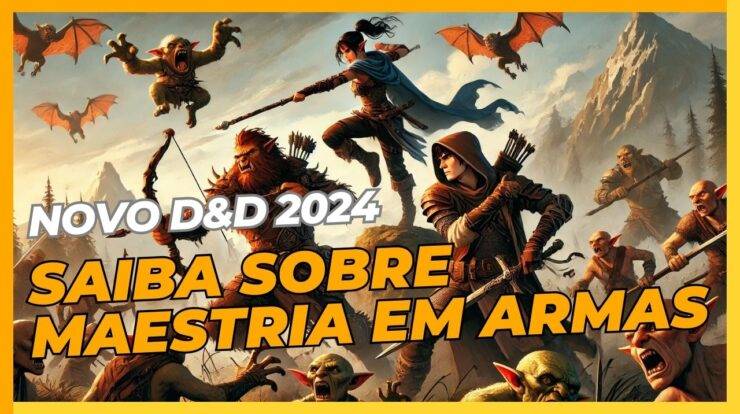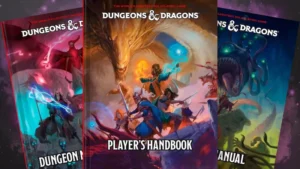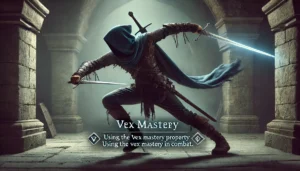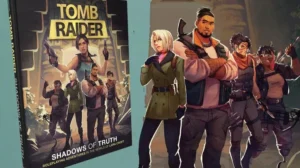
What is Weapon Mastery in Dungeons and Dragons?
Weapon Mastery is a groundbreaking class feature in the new Player’s Handbook 2024. Primarily, it reflects the specialization and mastery that characters have with certain types of weapons.
Additionally, each weapon in the book now includes a mastery property in addition to its regular properties.
In other words, this allows characters to utilize these weapons in unique and effective ways.
This new feature, for example, enriches the gaming experience, enhancing the role of each class on the battlefield.
This makes combat more dynamic and interesting, providing a more engaging experience for all players.
Primarily, weapon mastery allows characters to explore new forms of combat, adapting their skills and tactics as they face different challenges.
Mastery Properties

Each weapon does not Player’s Handbook 2024 has a specific mastery property that adds to the weapon’s normal properties.
For example, heavy weapons like the Greataxe can have the Cleave property, allowing additional attacks against nearby enemies.
As such, these properties are designed to complement the abilities of the different classes, offering strategic options that can change the course of a battle.
How does Weapon Mastery work?

Buy the new D&D 2024 book on Amazon
Weapon Mastery works dynamically and flexibly, allowing characters to adjust their skills as they acquire new weapons and gain experience.
During a Long Rest, you can practice maneuvers with a new weapon and learn its mastery properties.
This training process is therefore not permanent, allowing for changes in mastery properties as needed.
Learning and Adaptation
The number of mastery properties a character can learn and use depends on their class.
For example, barbarians and fighters start with more mastery properties compared to paladins and rogues.
This reflects the martial nature of these classes, which rely heavily on their weapon skills to overcome challenges.
- Barbarians and Warriors: They start with two and three mastery properties respectively, and can learn more as they level up.
. - Paladins, Rangers and Rogues: They start with two mastery properties based on their proficiency with simple and martial weapons. Rogues, specifically, have access to weapons with either the Finesse or Light properties.
Additionally, certain subclasses may grant access to additional or specific mastery properties.
For example, a Soulknife Rogue can use the Vex property with his psychic blades without it counting towards the mastery cap learned.
Combat Use
Once a character learns a weapon’s mastery property, he can use that property every turn during combat, as long as he is wielding the weapon in question.
Different mastery properties have different triggers. For example, Cleave requires you to hit a creature with a melee attack, while Graze activates when you miss with an attack.
Flexibility
One of the main advantages of weapon mastery is its flexibility. As such, characters are not limited to using the same mastery properties indefinitely.
During a Long Rest, they can practice with new weapons and exchange a mastery property they already know for a new one.
This way, the characters adapt to different situations and challenges, keeping the game always interesting and dynamic.
In short, weapon mastery in Player’s Handbook 2024 not only adds depth to the Dungeons & Dragons combat system, but also offers players an exciting way to customize and evolve their characters as they progress through the adventure.
Examples of Mastery Properties
Cleave

Weapon Example: Great Axe
If you’re in the thick of battle, consider a weapon with the Cleave property. These heavy weapons can cut through opponents.
So if you hit a creature with a melee attack, you can make a second attack against a creature within 5 feet of you.
When you hit with the second attack, you can roll weapon damage, but you don’t add the ability modifier unless it’s negative.
Graze
Weapon Example: Greatsword
Graze is great for increasing the consistency of your weapon’s damage. If you miss with an attack, you deal damage equal to the ability modifier used to make the roll.
This pairs well with skills that allow for a lot of attacks, like the Warrior’s Extra Attacks.
Nick
Weapon Example: Dagger
To explain the Nick property, it is important to briefly cover that attacking twice with Light weapons has changed in the Player’s Handbook 2024.
The rules for using two Light weapons are now under the Light property. Nick allows making the additional attack when using Light weapons as part of the initial attack action.
This frees up your Bonus Action for other abilities, such as the Rogue’s Cunning Action.
Push
Weapon Example: Greatclub
Pushing an enemy off a cliff or into a lava pit can win a tough battle.
The Push property allows you to push a creature 10 feet away when you hit it, without requiring a check. This is great for combining with environmental hazards or for escaping attacks of opportunity.
Sap

Weapon Example: Mace
If your job is to distract enemies, Sap is a good choice.
When hitting an enemy, this property imposes Disadvantage on their next attack before the start of your next turn.
So your enemies will be so focused on trying to take you down that they won’t even see the fireball coming.
Slow
Weapon Example: Light Crossbow
Slow is great for fast characters who like to move around the battlefield. When you hit a creature and deal damage, you reduce its Speed by 10 feet until the start of your next turn.
This pairs well with the Light Crossbow, allowing you to attack, deal damage, and move away from the slowed creature.
Topple
Weapon Example: Mallet
Topple is ideal for builds that perform multiple melee attacks.
When you hit a creature, you can force it to make a Constitution save or be knocked prone. The DC is 8 + your ability modifier + your Proficiency Bonus.
A level 5 Warrior, for example, could knock down an opponent with the first attack and use subsequent attacks with Advantage.
Vex

Weapon Example: Short Sword
Vex allows a superior swordsman to dance around an opponent, exploiting openings until he wins the battle.
When you deal damage, you gain Advantage on your next attack before the end of your next turn. This is great for Rogues to secure a Sneak Attack next turn.
Conclusion
Weapons Mastery in the New Player’s Handbook 2024 offers more choices in combat. It reinvigorates weapon usage in Dungeons & Dragons, making combat more strategic and engaging.
Stay tuned for more 2024 rules guides and keep exploring what’s coming!
Source: https://www.caixinhaquantica.com.br/guia-maestria-armas-dungeons-and-dragons-2024/


